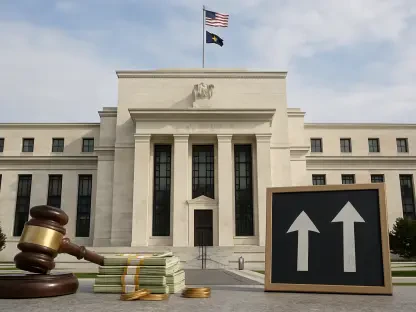The financial landscape is undergoing a profound transformation as stablecoins, a type of digital currency pegged to fiat money and built on blockchain technology, rise to prominence with the potential to disrupt traditional banking systems. These innovative assets are not just a passing trend but a serious contender, offering stability in value and significantly higher yields compared to the often negligible interest rates provided by conventional savings accounts. As Patrick Collison, CEO of Stripe, has pointed out, this growing appeal of stablecoins could compel banks to reevaluate their deposit offerings to prevent a significant loss of customers to these tech-driven alternatives. The disparity between what banks currently offer and the returns available through stablecoins is creating a competitive tension that may redefine how financial institutions operate. This article delves into the dynamics of this emerging challenge, exploring how stablecoins are pushing banks to share yields and adapt to a rapidly evolving digital economy.
The Appeal of Yield-Bearing Digital Currencies
Stablecoins are carving out a substantial niche in the financial world by combining the reliability of fiat-backed value with the promise of attractive returns. In the U.S., where the average interest rate on savings accounts lingers at a mere 0.40%, and even less in regions like the European Union, stablecoins stand out by offering yields that often align more closely with market rates. This stark contrast has not gone unnoticed by depositors, who are increasingly drawn to digital platforms that provide a better return on their money. The efficiency of blockchain technology further enhances the appeal, enabling seamless transactions and reducing costs that traditional banks often pass on to customers. As a result, stablecoins are not just an alternative but a compelling option for savers seeking to maximize their earnings in a low-interest environment, putting undeniable pressure on banks to reconsider their approach to deposit interest.
This shift toward stablecoins is fueled by a growing awareness among consumers of the potential for higher earnings without sacrificing stability. Unlike volatile cryptocurrencies, stablecoins maintain a steady value, making them a safer bet for risk-averse individuals looking to grow their savings. The ability to earn yields closer to what the market offers, rather than the minimal rates banks provide, is a game-changer for many. This trend is particularly evident among tech-savvy younger generations who are comfortable with digital wallets and blockchain platforms, further accelerating the adoption of these digital currencies. Banks, which have long relied on depositors accepting low returns as a given, now face a critical challenge to match or exceed these competitive rates. Failure to do so risks alienating a significant portion of their customer base, as the allure of better financial rewards through stablecoins continues to gain momentum in the global economy.
Banking Models Under Siege
Traditional banks have historically built their profitability on the spread between the low interest rates paid to depositors and the higher rates charged on loans. However, as Stripe’s Patrick Collison has emphasized, the advent of stablecoins with attractive yields is disrupting this long-standing model by offering savers a viable alternative. When digital currencies can provide returns that far outstrip those of a standard savings account, depositors have little incentive to keep their funds in banks that fail to compete. This competitive threat is not just theoretical but a tangible risk, as more individuals and businesses explore blockchain-based options for storing and growing their wealth. The potential for a significant outflow of deposits looms large, forcing financial institutions to confront the reality that their traditional business structure may no longer be sustainable in this new digital era.
The implications of this shift extend beyond mere interest rates to the very foundation of how banks operate. If depositors continue to migrate toward stablecoins for better yields, banks could see a dramatic reduction in the low-cost capital they rely on for lending and other operations. This erosion of their deposit base would not only impact profitability but also limit their ability to fund loans, potentially tightening credit availability in the broader economy. To counter this, banks may need to overhaul their offerings, perhaps by introducing higher-yield deposit products or integrating blockchain technology to remain relevant. The urgency to adapt is clear, as the longer banks delay in responding to the stablecoin challenge, the greater the risk of losing market share to these innovative digital alternatives that are reshaping consumer expectations around financial returns.
Regulatory Hurdles and Industry Pushback
The rapid rise of stablecoins has caught the attention of regulators and traditional financial institutions, who view these digital currencies as a potential destabilizing force in the banking sector. U.S. lawmakers, including Senator Kirsten Gillibrand, have expressed concern that yield-bearing stablecoins could siphon deposits away from banks, thereby undermining the stability of the broader financial system. Such fears are not unfounded, as a significant shift of funds to digital platforms could weaken banks’ ability to lend and support economic growth. In response, the banking industry has advocated for stringent regulations, evidenced by legislative efforts like the GENIUS stablecoin bill passed a couple of years ago, which establishes a framework for digital currencies but imposes limits on certain yield-sharing practices. This defensive stance highlights the tension between fostering innovation and protecting established financial structures.
While regulatory pushback aims to safeguard the traditional banking system, it also risks stifling the growth of a technology that many see as the future of finance. The restrictions embedded in recent legislation reflect a broader apprehension among financial authorities about the systemic risks posed by stablecoins, particularly if their adoption accelerates unchecked. However, these measures may only delay the inevitable, as consumer interest in higher-yield digital options continues to grow despite regulatory barriers. Banks, caught between regulatory constraints and competitive pressures, face a complex challenge in balancing compliance with the need to innovate. Meanwhile, stablecoin issuers argue that their products enhance financial inclusion and efficiency, pushing back against rules that could limit their ability to offer competitive returns. This ongoing tug-of-war between regulation and innovation will likely shape the trajectory of stablecoins in the coming years.
Envisioning a Digital Financial Future
Stablecoins are not merely a competitive threat to banks but also a harbinger of a deeper transformation in the concept of money itself. Industry leaders like Reeve Collins, co-founder of Tether, envision a future where digital currencies could supplant traditional fiat money, even while retaining familiar labels like dollars or euros. This bold prediction suggests a world where financial transactions are predominantly conducted on blockchain platforms, offering speed, transparency, and reduced costs compared to current systems. Such a shift would place immense pressure on banks to either integrate with or compete against this digital-first paradigm, as failing to do so could render them obsolete in a landscape increasingly defined by technological advancement. The idea of money evolving into a fully digital form raises profound questions about the role of traditional financial institutions.
This vision of a digital financial future is not without its challenges, but the momentum behind stablecoins indicates a strong push toward realization. Their ability to facilitate cross-border transactions with minimal fees and delays is already attracting businesses and individuals alike, further embedding digital currencies into everyday finance. As adoption grows, banks may find themselves compelled to adopt blockchain solutions or partner with stablecoin providers to stay relevant. The potential for stablecoins to redefine savings, payments, and even lending practices underscores the urgency for the banking sector to rethink its strategies. While the complete transition to digital money may still be on the horizon, the steps taken now by both stablecoin innovators and traditional banks will likely determine the shape of global finance in the decades ahead, highlighting the critical crossroads at which the industry currently stands.
The Power of Consumer Choice
The surge in stablecoin popularity is largely driven by consumer demand for better financial returns and more efficient transaction methods. Since regulatory frameworks began evolving a couple of years ago, the market size and user base for stablecoins have expanded significantly, reflecting a persistent trend that traditional banks cannot overlook. Depositors are increasingly prioritizing options that align with market conditions over the historically low rates offered by conventional accounts. This shift in preference sends a powerful message to financial institutions: adapt to the new reality of shared yields or risk losing relevance in a market where consumers wield greater choice. The growing traction of stablecoins is a clear indicator that savers are ready to embrace alternatives that better meet their financial needs.
This consumer-driven change is reshaping the competitive landscape, compelling banks to confront the limitations of their current offerings. The expectation for higher yields is not a fleeting demand but a fundamental shift in how individuals view the value of their money. Stablecoins, with their promise of stability and profitability, are empowering users to seek out platforms that prioritize their financial growth. For banks, the challenge lies in innovating deposit products or integrating digital currency solutions to recapture depositor loyalty. As the influence of consumer choice continues to grow, the financial sector must recognize that the era of passive acceptance of low returns is fading. Moving forward, the ability to meet these evolving expectations with competitive and tech-forward solutions will be crucial for banks aiming to maintain their foothold in an increasingly digital financial ecosystem.









